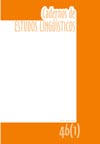Resumo
In order to support with semiotic information the research in the field of phonostylistics, we propose a formula that allows turning a subjective and emotional information of one verbal text into quantitative information, from one analysis of temporality as a constitutive element of emotion. It gives us coordinates for a graphic that represents the variation of tension in the text sentence by sentence. It supports simultaneously the representation of prosodic information, such as speech rate in absolute values and, in relative values, the deviation of the duration of speech segments according to the expected patterns. In this paper we present the linguistic basis for this analysis, from a hierarchy of the sense of temporality to the graphics of the modulation of the deep temporal flow.Referências
BARBOSA, P.A. (1996). At Least two macrorhytmic units are necessary for modeling Brazilian Portuguese duration: emphasis on segmental duration generation. Cadernos de Estudos Lingüísticos, 31, pp. 33-53.
BARBOSA, P.A. (2000). “Syllable-timing in Brazilian-Portuguese”: uma crítica a Roy Major. Revista Delta vol. 16, no 2, pp. 369-402.
FONTANILLE, J. & ZILBERBERG, C. (2001). Tensão e Significação/ trad. Ivã Carlos Lopes, Luiz Tatit e Waldir Beividas. – São Paulo: Discurso Editorial: Humanitas/FFLCH/USP.
GREIMAS, A.J. & COURTÉS, J. (sem data). Dicionário de Semiótica/ trad. Alceu Dias Limas, Diana Luz Pessoa de Barros, Eduardo Peñuela Cañizal, Edward Lopes, Ignácio Assis da Silva, Maria José Castagnetti Sembra e Tieko Yamaguchi Miyazaki. São Paulo, Ed. Cultrix.
GREIMAS, A.J. & FONTANILLE, J. (1993). Semiótica das Paixões - dos estados de coisas aos estados de alma./trad. Maria José Rodrigues Coracini. Série Temas # 33. São Paulo, Ed. Ática.
HJELMSLEV, L. (1968). Prolégomènes a une Théorie du Langage - et - La Structure Fondamentale du Langage. /trad. Anne-Marie Léonard. Série Arguments # 35. Paris, Les Editions De Minuit.
HOLLANDA FERREIRA, A.B. (1988). Dicionário Aurélio Básico da Língua Portuguesa. Rio de Janeiro, Ed. Nova Fronteira.
MATTE, A.C.F. (2004). “Tempo fonoestilístico e semi-simbólico: a árvore gerativa da temporalidade”. Estudos Lingüísticos V. XXXIII. GEL: Campinas, SP, 2004.
SAUSSURE, F. (1989). Cour de linguistique générale./ Ed. critique par Rudolf Engler. Wiesbaden: Harrassowitz.
ZILBERBERG, Cl. (1990). “Relativité du rythme”. In Protée – Théories et Pratiques Sémiotiques. Département des Arts et Lettres de l’Université du Quebec à Chincontimi. Vol. 18, n.o 1, pp. 37-46.
O periódico Cadernos de Estudos Linguísticos utiliza a licença do Creative Commons (CC), preservando assim, a integridade dos artigos em ambiente de acesso aberto.

